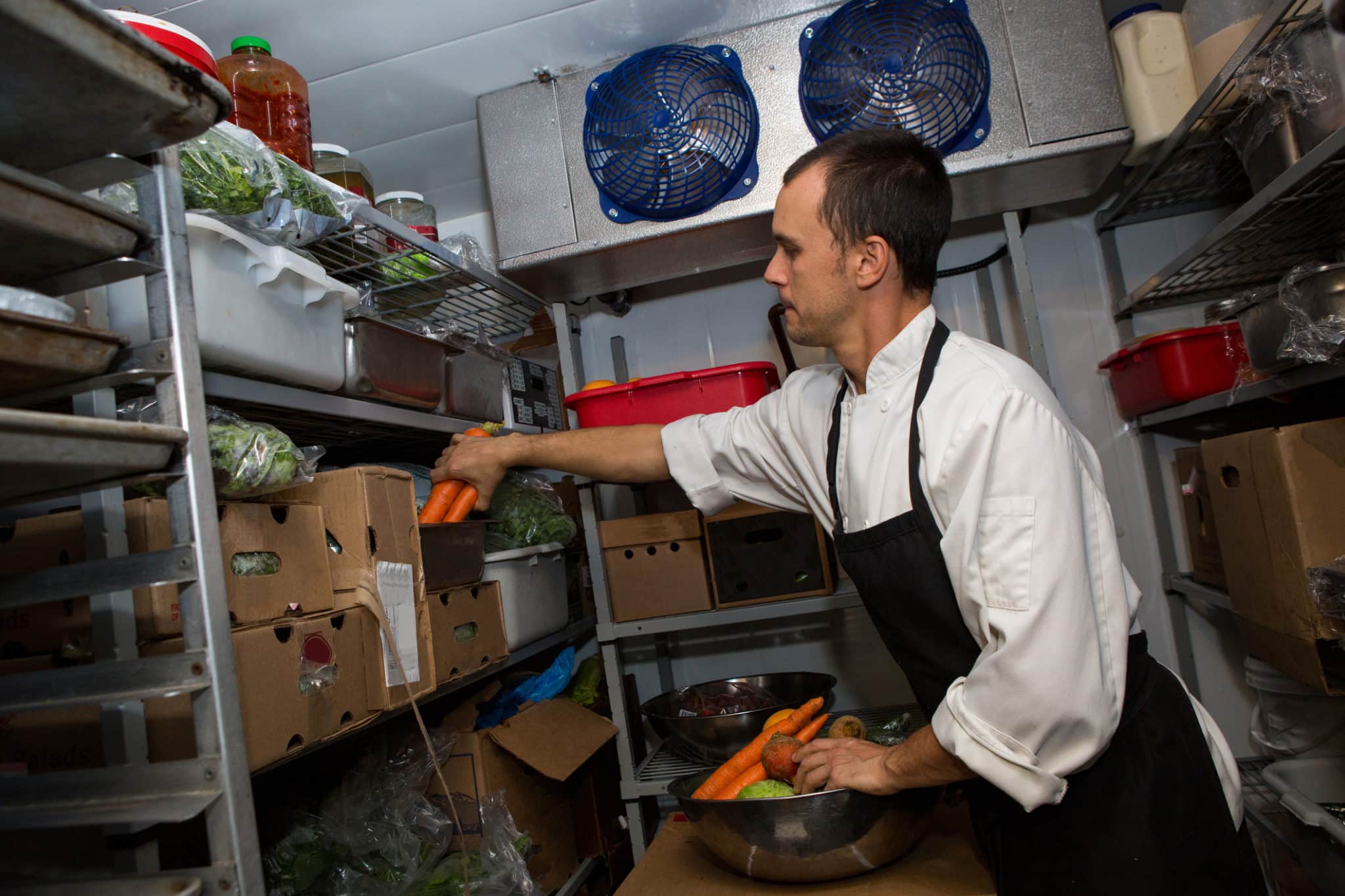As a restaurant operator, food is your life. It is a passion, obsession, and one of the most significant determinants of your business’s success and growth and your team’s well-being. With rising wholesale prices and inflation coupled with a shortage of knowledgeable, dedicated staff, food inventory management is more important than ever. Effective food inventory management helps restaurant owners and groups provide excellent food and experiences that lead to more profit and growth.
What does food inventory mean?
Food inventory management is the process of monitoring and perfecting the purchase, storage, use, and sale of the primarily perishable ingredients that are the basis for everything a restaurant does. Menu engineering and food costing are critical parts of that workflow so organizations can manage through any situation and produce consistently growing margins and profits. The right food inventory management process ensures your restaurant always has the right amount of ingredients on hand, so your team always has everything it needs to produce those iconic dishes.
What is Inventory Management in a Restaurant?
Inventory management in a restaurant is the systematic process of ordering, storing, and tracking ingredients, beverages, and other supplies critical for operations. For any restaurant, inventory serves as both a resource and an investment; managing it effectively can mean the difference between profitability and financial strain. When properly organized, inventory management allows restaurants to minimize waste, optimize purchasing, and maintain quality control over every item served.
Effective inventory management goes beyond simple stocktaking. It involves tracking each ingredient and supply item to monitor what is used, what is needed, and when reordering is necessary. This process helps avoid both excess and shortage—two costly issues for any restaurant. While excess inventory leads to spoilage and waste, running out of stock can disrupt service, affecting customer satisfaction and potentially damaging the restaurant’s reputation.
How Often Should a Restaurant Do Inventory?
The frequency of inventory checks in a restaurant largely depends on the restaurant’s size, menu complexity, and volume of sales. Generally, many restaurants perform inventory counts weekly, particularly for high-turnover items like produce, proteins, and dairy that have limited shelf lives. A weekly review helps to align orders with actual usage, preventing stockouts or excessive spoilage.
Some establishments, especially high-volume or fine-dining restaurants, may perform daily inventory checks on essential or high-cost items. For example, tracking seafood, prime cuts, or specialty ingredients daily can ensure freshness and maintain control over food costs. Additionally, inventory checks after peak times, such as weekends, can provide insights into consumption patterns and guide ordering decisions for the coming week.
Monthly or quarterly counts are also common for non-perishable items or supplies that don’t fluctuate as frequently. By reviewing inventory on a regular basis, restaurants can maintain tight control over their expenses and more accurately project their future needs, enabling smoother operations and reducing the risks of over-ordering or running out.
What is a Perpetual Inventory System?
A perpetual inventory system is an advanced method for tracking inventory continuously in real-time. Instead of periodic manual checks, this system uses software to automatically record changes in inventory every time an item is received, sold, or discarded. Each transaction updates the stock levels instantly, providing an ongoing and highly accurate view of inventory status.
This system is particularly advantageous for restaurants with extensive menus or large inventories, as it reduces the need for labor-intensive manual counts and offers more precise data on stock levels. By providing real-time insights, a perpetual inventory system allows managers to make immediate purchasing decisions based on current stock, reducing the likelihood of overstocking or running out.
Moreover, perpetual inventory systems often integrate with point-of-sale (POS) systems, making it easier to track ingredient usage linked to menu items. This integration gives restaurants a clear view of food costs, waste, and menu profitability. While implementing a perpetual inventory system requires an upfront investment in technology and possibly additional training, the benefits it offers in terms of operational efficiency, cost control, and data accuracy make it a worthwhile choice for many restaurant owners.
What is the RFID Inventory System?
RFID (Radio Frequency Identification) inventory systems represent a more sophisticated approach to tracking inventory, utilizing RFID tags attached to items. These tags contain electronically stored information that can be read remotely by an RFID reader. This technology allows restaurants to monitor their inventory quickly and accurately without physical contact, making it ideal for busy, high-turnover environments.
In a restaurant setting, RFID can help streamline inventory management by automating item identification and stock updates. For instance, by attaching RFID tags to high-value or frequently used ingredients, restaurants can track their movement and stock levels with precision. This system not only reduces the time required for manual counting but also minimizes human errors, as the automated scanning ensures every item is accounted for accurately.
RFID inventory systems are especially useful for large-scale or multi-location restaurant operations where inventory control is complex and labor-intensive. By providing real-time visibility into stock levels and movement, RFID systems aid in demand forecasting, enhance security by preventing theft, and help maintain optimal inventory levels. While RFID implementation involves higher initial costs, its potential to reduce labor costs, prevent losses, and improve inventory accuracy offers a significant return on investment for restaurants aiming to optimize their inventory management.
Why is inventory management important in the food and restaurant industry?
The right food inventory management strategies, tactics, and tools can improve the operations and performance of individual restaurant locations and large restaurant groups. The ultimate benefits are rising margins and profits and improving guest experiences that help your business to earn more, pay more, and grow more. Below are just a few of the benefits:
- Prevent food loss through waste, spoilage, theft, over-ordering, or misfiring
- Establish and perfect portion control
- Lower Cost of Goods Sold
- Ensure accurate supplier prices
- Eliminate costly manual inventory errors
- Save time by automating manual food inventory management tasks
For more great tips check out other blogs:
- Four Restaurant Inventory Management Tips and Best Practices
- Restaurant Inventory Spreadsheet to Get Started with Inventory Management
Common food inventory management terms
As is the case in every walk of life, restaurants have their own vocabulary. Those below are just as important as fire, behind, on the fly, and 86’d to help your operation run at peak performance every shift.
Sitting inventory
The stock, measured in dollars, weight, volume, quantity, etc., of what’s available in your kitchen. It’s important to decide which unit of measurement you plan to use to quantify sitting inventory and to stick with it to ensure consistent, reliable metrics.
Shelf-to-sheet
An inventory method that counts what’s in your dry storage, walk-ins, freezers, low boys, and everywhere else and matches it against your food inventory management system. This can be done manually, but growth-minded operators are quickly shifting to all-in-one Restaurant Enterprise Management platforms that enable digital inventory counts on mobile devices with data immediately fed into a cloud-based system. You can improve accuracy by arranging shelves and other storage facilities to match the order of ingredients on your inventory lists.
Depletion
How much inventory your kitchen uses over a particular period, whether a single shift or a month. This should be provided by a point-of-sale (POS) system, which ideally integrates with an end-to-end restaurant management platform that can quickly offer cost analysis data.
Usage
A predictive metric for determining how much of a particular ingredient you’ll need based on historical depletion. Let’s say you have 100 pounds of a custom ground beef blend for your famous smash burgers in the walk-in. You sell 50 burgers a day, each with two, two-ounce patties, making your depletion 12.5 pounds of meat a day. That means you have enough ground beef on hand for eight days.
Cost of Goods Sold
Cost of Goods Sold (CoGS)—also known as your food cost—represents the total cost of all food and beverage ingredients used in your restaurant over a certain period. CoGS covers all the ingredient costs related to your sales, but it doesn’t include types of one-time, non-inventory costs, such as equipment repairs or new dining room decor. Here’s a quick formula
Starting Inventory in dollars + Additional Purchases – Ending Inventory = COGS
Yield
The useable amount of an ingredient left after cleaning or trimming. It could refer to what’s left after cleaning up a quarter primal, or how much fruit remains after cutting up a pineapple. Yield is most often expressed as a percentage.
Actual vs. Theoretical
Often abbreviated as AvT, this requires restaurant operators to embrace integrated restaurant technology and its ability to gather, manipulate, and convey data in a way that isn’t possible using pen and paper or generic software or solutions. In restaurant inventory and operations, theoretical refers to how much product you should’ve used based on preset recipes. Actual is how much the kitchen used.
Variance
Variance is the difference between actual and theoretical inventory levels. It could be in dollars, percentages, or physical amounts. Variance is how you identify where your profits might be leaking, and your high-performing stores or team members reside, who can serve as mentors to the rest of your organization.
How do you track food inventory?
Here’s where the rubber hits the road, or better yet, where the steak hits the grill. The key to effective food inventory management to track your food inventory and associated costs is to develop a detailed strategy, the specific tactics it includes, and ensure consistency. Taking inventory is essentially coming up with a data set, and your data will only be as reliable as the system and the individuals that created it. Additionally, it’s important to remember that data is merely a real-time snapshot. Your full count from last month and your flash count of your 20 most-used items from last week aren’t going to work for this week. Below are several critical best practices for tracking food inventory and setting all of your locations and your overall business up for reliable growth.
Train your team
As an operator or owner, it’s unlikely that you will take every inventory count. Just as it takes a well-oiled machine of a team to put out dozens, possibly hundreds, of perfect plates each shift, inventory is all about teamwork. Be sure to train every team member in every facet of inventory, including sheet-to-shelf, the system you use for inventory, and units of measurement. Alongside inventory is the importance of tracking waste. Incentivize your team to keep waste logs and track when misfiring, poor portioning, overage, or spoilage occurs. Preach the importance of avoiding and tracking waste on the performance of the business. Consider incentives for team members who track the most waste or those who reduce waste by the largest margin.
Organize your space
If you’re taking sheet-to-shelf inventory, your shelves must match your sheets (or screens, better yet). Not only will organization lead to more accurate inventory and a greater ability to control margins and boost profits, but it will also improve your overall team performance and guest satisfaction.
Take inventory often
Set up a recurring schedule for inventory at the same time and day each month. Avoid counting when the restaurant is amid a rush or deliveries, which could lead to double counting. Also, consider flash counts of your top 10 or top 20 ingredients, which can often account for as much as 80% of your costs.
Improve, improve, improve
Once you get started, you’ll often find gaps in the process. If your team is trained and engaged, they can help ensure suppliers’ deliveries match orders in quantity and price, practice First In, First Out (FIFO) to help cut down unnecessary waste and adjust how they take inventory to produce better results.
Track daily sales reports
It’s easy to get overwhelmed by everything that happens in a restaurant daily, but checking your key metrics isn’t something to let slide. Doing so will help you spot trends or problems as they arise and give you a better feel for the ebbs and flows of the kitchen and its vast inventory. The combination of sales metrics, precise inventory data, and automated analyses gives corporate-level operators and store-level managers the ability to confidently make small changes that yield big results.
Conclusion
Today’s restaurants face complex challenges that require modern solutions. While businesses in other industries spend as much as 8% of their gross annual revenues on technology, the restaurant industry hovers somewhere between one and 2%. Given the profound, fast changes across the business, restaurants can’t rely on old practices to prevail in the face of new challenges and opportunities.
Food inventory management is only one example. By leveraging an integrated, all-in-one Restaurant Enterprise Management platform, operators, managers, and their teams can conduct inventory counts faster and more often, producing better data that provide actionable insights into where problems are arising, and challenges are hiding. In doing so, restaurants will access inventory metrics that were once nearly impossible to produce manually or with generic accounting solutions alongside the data-backed confidence to make small or large adjustments to all aspects of the operations in pursuit of better guest experiences, profits, and growth.



